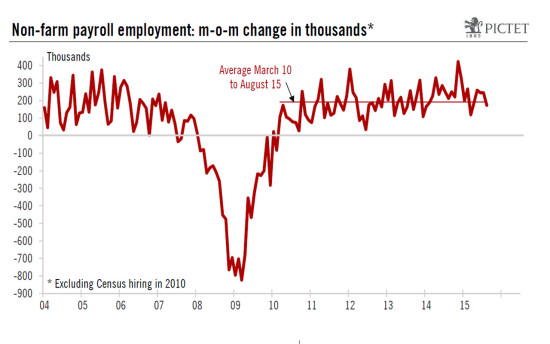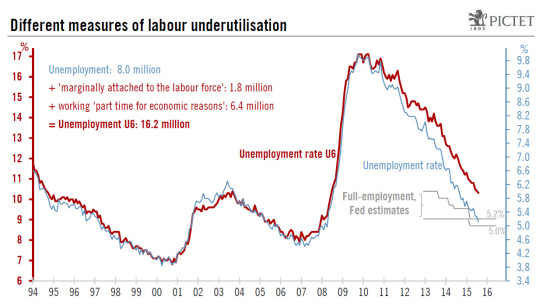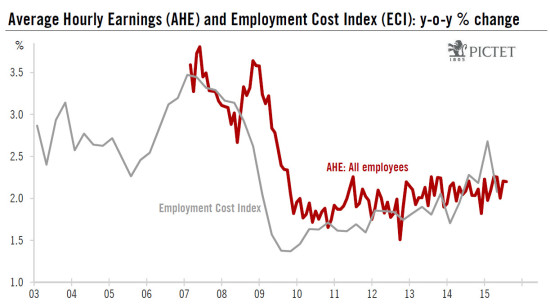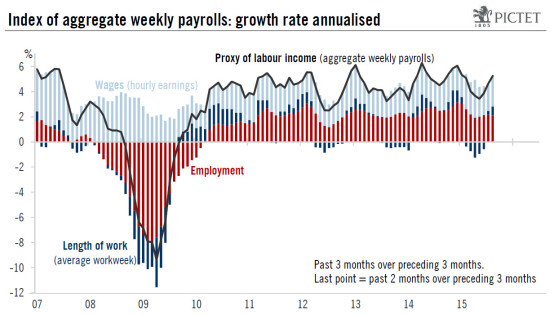In August 2015, job creation came in below expectations, but both June’s and July’s numbers were revised up, and most other indicators in today’s employment report were rather upbeat, including a marked drop in unemployment. Although it remains a tight call, we continue to believe the most likely scenario is for the Fed to wait until December before hiking rates. Non-farm payroll employment rose by 173,000 m-o-m in August 2015, below consensus expectations (217,000). However, July’s figure was revised up (from 215,000 to 245,000), as was June’s number (from 231,000 to 245,000). Cumulative net revisions thus worked out at a positive 44,000. So far in Q3, job creation has continued at a healthy pace, averaging 209,000 in July-August, almost the same reading as on average in H1 (213,000). Unemployment rate fell heavily m-o-m in August Meanwhile, surprisingly, the unemployment rate fell from 5.3% in July to 5.1% in August, below consensus expectations (5.2%). A more in-depth look at the household survey (the basis for calculating the unemployment rate) reveals that employment as measured in the household survey – an often very volatile statistic – rose by a solid 196,000 m-o-m in August, following a 101,000 increase in July. Moreover, at the same time, the size of the labour force shrank by 41,000 m-o-m, following a 69,000 rise in July.
Topics:
Bernard Lambert considers the following as important: Macroview
This could be interesting, too:
Cesar Perez Ruiz writes Weekly View – Big Splits
Cesar Perez Ruiz writes Weekly View – Central Bank Halloween
Cesar Perez Ruiz writes Weekly View – Widening bottlenecks
Cesar Perez Ruiz writes Weekly View – Debt ceiling deadline postponed
In August 2015, job creation came in below expectations, but both June’s and July’s numbers were revised up, and most other indicators in today’s employment report were rather upbeat, including a marked drop in unemployment.
Although it remains a tight call, we continue to believe the most likely scenario is for the Fed to wait until December before hiking rates.
Non-farm payroll employment rose by 173,000 m-o-m in August 2015, below consensus expectations (217,000). However, July’s figure was revised up (from 215,000 to 245,000), as was June’s number (from 231,000 to 245,000). Cumulative net revisions thus worked out at a positive 44,000. So far in Q3, job creation has continued at a healthy pace, averaging 209,000 in July-August, almost the same reading as on average in H1 (213,000).
Unemployment rate fell heavily m-o-m in August
Meanwhile, surprisingly, the unemployment rate fell from 5.3% in July to 5.1% in August, below consensus expectations (5.2%). A more in-depth look at the household survey (the basis for calculating the unemployment rate) reveals that employment as measured in the household survey – an often very volatile statistic – rose by a solid 196,000 m-o-m in August, following a 101,000 increase in July. Moreover, at the same time, the size of the labour force shrank by 41,000 m-o-m, following a 69,000 rise in July. The end-result was that the number of unemployed dropped by a substantial 237,000 (-41,000 minus 196,000) while the participation rate (the proportion of the adult population working or looking for a job) remained flat at 62.6% (after rounding). This means that the decline in unemployment was mainly linked to solid job creation, but also to a modest drop in the labour force.
At 5.1%, the unemployment rate is already below the Q4 projections the FOMC published back in June (5.2%-5.3%), and – more importantly – just beneath the top end of the range the Fed considers to correspond to full employment (5.0%-5.2%). Moreover, it is worth remembering this latter range was lowered from 5.2%-5.5% as recently as March.
The Fed has admittedly repeated many times that the unemployment rate probably underestimates the amount of resources available in the labour market. However, even if we consider a wider measure of unemployment, i.e. the U6 measure – which includes (1) employees working part-time, but who would prefer a full-time job, and (2) people who want a job, are available for work, have looked for a job sometime over the past 12 months, but did not do so during the current survey week so were not counted as unemployed – it fell heavily in H1 2015. And it has declined further so far in Q3, falling from 10.5% in June to 10.4% in July, and now to 10.3% in August. On this yardstick too, full employment does not look all that far away (see chart above). According to our estimates, it should be reached by around Q2 2016.
Meanwhile, average hourly earnings rose by 0.3% m-o-m in August, above consensus estimates (+0.2%). However, on a y-o-y basis, wage increases remained stable at 2.2%. This series is quite volatile (see chart at bottom of previous page), but, according to these numbers, the pace of wage increases looks to have remained on a flat trend so far this year, with monthly y-o-y increases hovering around a modest 2.2%.
These results are pointing in the same direction as the quarterly Employment Cost Index (ECI) – the most reliable measure of wages and salaries – i.e. to no noticeable acceleration in wage increases so far this year. However, we continue to expect wage increases gradually to pick up further over the coming few quarters.
The average working week up so far in Q3
The average workweek was published at 34.6 hours in August, up from a downwardly revised 34.5 hours in July. This represents an encouraging sign. The average workweek averaged 34.5 hours in Q2 and, in terms of total hours worked, an increase of 0.1 hours is equivalent to some 350,000 jobs being created.
As a result of all this, the index of ‘aggregate weekly payrolls’ (calculated as a product of aggregate hours worked and average hourly earnings) rose by a strong 0.7% m-o-m in August, after +0.4% in July. As such, this index – which is a good proxy for nominal household income coming in the form of private wages and salaries – grew by a strong 5.3% annualised between Q2 and July-August (see chart above), after a softer 3.4% q-o-q annualised in Q2. This represents an encouraging development for growth in household income in Q3, and for consumer spending.
Healthy employment report
Although the pace of job creation in August did fall short of expectations, today’s employment report showed some further improvement in overall labour market conditions. Job creation in June and July was revised up, both the headline unemployment rate and the broader U6 measure fell m-o-m, wage numbers were above expectations, and ‘aggregate weekly payrolls’ have increased substantially so far in Q3.
In its last monetary policy statement at the end of July, the Fed clearly stated that the FOMC would raise rates when (1) “it has seen some further improvement in the labor market” and (2) “is reasonably confident that inflation will move back to its 2% objective over the medium term”. Following the last two employment reports and the publication of other labour market indicators, the first criterion has most probably been fulfilled. The second criterion is ostensibly more judgmental. And that is where the Fed is confronted with a dilemma. On the one hand, H2 growth prospects look encouraging, and, as we have seen above, the US economy has reached – or is rapidly approaching– full employment. This gives confidence that, at some stage or other, inflation will pick up. On the other hand, core PCE inflation in July dipped to its lowest level in more than four years, inflation expectations have softened recently, wage growth has been surprisingly disappointing overall, and both the dollar’s rise and the fall in commodity prices are likely to contribute to keeping inflation at low levels for quite a while. Moreover, with the trade-weighted dollar on the rise and financial markets in turmoil, monetary and financial conditions have tightened appreciably of late. This kind of tightening could easily be considered as tightening enough, without adding a rate hike to it, at least for the time being.
We continue to judge a December hike the more likely
Overall, we believe the Fed remains confident that a rate hike will prove appropriate before the year is out, but question-marks over the exact timing of this first hike are still unanswered. A September hike – i.e. in two weeks’ time – clearly remains a distinct possibility, but, for our part, we continue to accord a slightly higher probability to a December move over a September one. In any case, our rate forecasts are unchanged: we expect the target range on the Fed funds rate to end this year at 0.25%-0.5% (only one 25bp hike in 2015) and next year at 1.0%-1.25% (three 25bp hikes).




